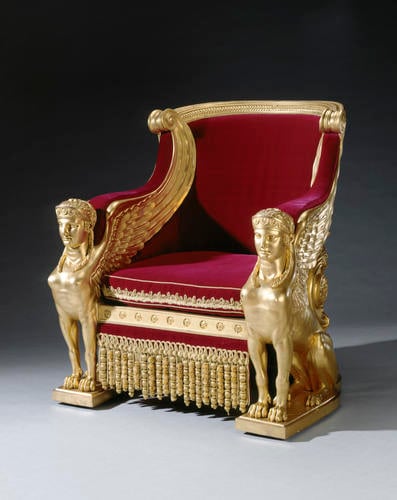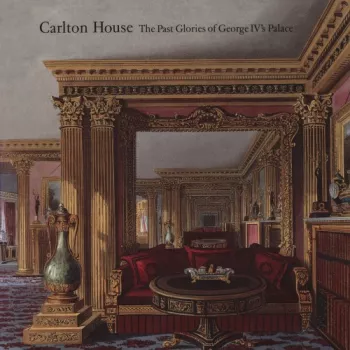Pair of council chairs 1812
Gilt wood, velvet upholstery | 108.6 x 94.0 x 96.5 cm (whole object) | RCIN 2629
-
Pair of council chairs of carved and gilded pine and beechwood, covered in red velvet with gold trimmings and fitted with a cushion and valance. Backs shaped like Roman chariots, are solid to the ground and elaborately carved, as is the whole. Padded velvet armrests supported on the wings and heads of two carved sphinxes, who sit on either side of each chair.
These magnificent chairs epitomise the fully developed Roman manner that George IV adopted for the interiors at Carlton House from c.1805 using the leading Mayfair cabinet-makers and interior decorators, Marsh & Tatham (subsequently Tatham, Bailey & Sanders). The introduction of this grandiose style, which gathered pace after the establishment of the Regency in 1812, eventually obliterated the majority of Henry Holland's sophisticated and chaste neo-classical interiors which had been the hallmark of Carlton House in the late eighteenth century. The inspiration for the chairs, part throne, part triumphal chariot, comes from three ancient marble chairs, drawn in Rome by C.H. Tatham, brother of Thomas Tatham, and published in 1800. The impeccably Roman origin of the design, much embellished by Tatham, is underlined by the use of the word 'Antique' in the bill. Originally upholstered in a luxurious pale blue and gold fleur-de-lis satin, the chairs were part of a large and expensive group of seat furniture supplied by Tatham for the Blue Velvet Room in December 1812. The curtains of the room were made of the same fleur-de-lis satin and had been installed in time for George IV to receive the exiled French royal family there for the spectacular fête held on 19 June 1811 to inaugurate the Regency.
Early in 1813, George IV indulged in one of the sudden changes of mind which had always characterised his attitude to decoration: the new seat furniture was ordered to be re-covered in blue velvet and moved to the Old Throne Room. Later still, the coverings of the chairs were changed again to crimson velvet and they were moved to the new Throne Room (formerly the Great Drawing Room) where the Regent's Council met. After the demolition of Carlton House, the chairs were used by George IV in the State Apartments of St James's Palace.
More than twenty-five years later, the same round-backed chair design with sphinx arms was chosen for Queen Victoria's Homage Chair, made for her coronation in 1838 by Tatham's successor Edward Bailey at a cost of £86. This chair, which is shown in Hayter's portrait of the Queen, was taken as a perquisite after the coronation by the Lord Chamberlain, the second Marquess Conyngham. It was subsequently destroyed in a fire at Slane Castle.
Catalogue entry from Royal Treasures, A Golden Jubilee Celebration, London 2002Provenance
These chairs may possibly have been the '2 very large Antique Elbow Chairs' which were purchased by George IV when Prince Regent from Tatham & Co. in 1813 for £587-12-0. (PRO LC9/396, quarter to 5 January 1813).
-
Creator(s)
(furniture manufacturer)Acquirer(s)
-
Medium and techniques
Gilt wood, velvet upholstery
Measurements
108.6 x 94.0 x 96.5 cm (whole object)
Category
Object type(s)










